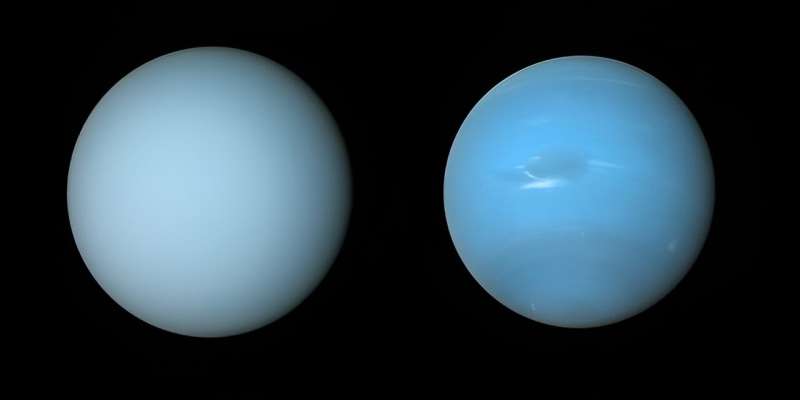NASA’s Voyager 2 spacecraft captured these views of Uranus (on the left) and Neptune (on the right) during its flybys of the planets in the 1980s. Credit: NASA
We have discovered more than 5,000 planets around other star systems. Among the veritable cosmic menagerie of exoplanets, it seems there is a real shortage of Neptune-sized planets close to their star.
A new paper just posted to the arXiv preprint server discusses a Saturn-sized planet close to its host star which should be experiencing mass loss, but isn't. Studying this world offers a new insight into exoplanet formation across the universe.
Exoplanets really are fascinating. Ever since their discovery the race has been on to discover and catalogue them. It gives us a great opportunity to explore a far more statistically significant set of data to understand planetary system formation rather than just studying are own system.
The absence of Neptune-mass exoplanets closer to the host stars in exoplanetary systems has been a bit of a mystery. Their lack has been attributed to one of two things: photoevaporation, in which mass is lost through ionization of gas by radiation, which then disperses away from the ionizing source; or high-eccentricity migration, in which the planets migrate through the planetary system, as we have seen with some of the giant planets in our solar system.
To distinguish between these two possibilities, a team of astronomers led by Morgan Saidel from the California Institute of Technology investigated the origins of TOI-1259 A b, which is a Saturn-mass exoplanet. It is in a 3.48 day orbit around a K type star at a distance putting it on the edge of the so called Neptune desert. A region around a star wherein there are no Neptune-sized planets.
In the case of TOI-1259 A b, it is thought that its low density means it is especially vulnerable to photoevaporation. Transit methods were used, observing with the Hale Telescope at Palomar Observatory in the 1083 nm helium line to probe the upper levels of the atmosphere.
The near-infrared spectrograph on Keck II showed that there was indeed atmosphere escaping, but at a rate lower than expected. The rate of gas loss through photoevaporation (1010.325 g s-1) is too low to have significantly altered the planet's mass even if it had formed in its current location.
Instead, the team believes that the presence of a white dwarf companion (TOI-1259 B) may have caused the planet to migrate inward after formation. Analyzing the orbital parameters of the planet and the binary star system reveal that high-eccentricity migration is a far more likely explanation.
Planetary migrations of this sort may leave a trace through accretion of elements in the planetary atmosphere. Quantities of H2O, CO, CO2 , SO2 and CH4 should be at detectable levels in the atmosphere of TOI-1259 A b. If they are observed through transmission spectroscopic studies, will reveal where in protoplanetary disk the planet formed in. Further studies will be required to finally answer this question.
More information: Morgan Saidel et al, Atmospheric Mass Loss from TOI-1259 A b, a Gas Giant Planet With a White Dwarf Companion, arXiv (2024). DOI: 10.48550/arxiv.2404.08736
Journal information: arXiv
Provided by Universe Today
























